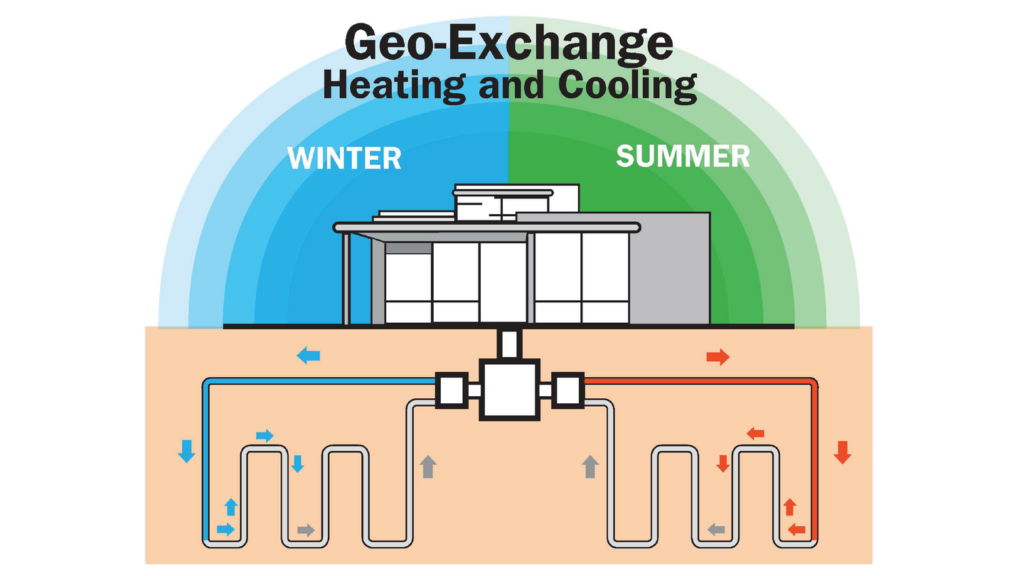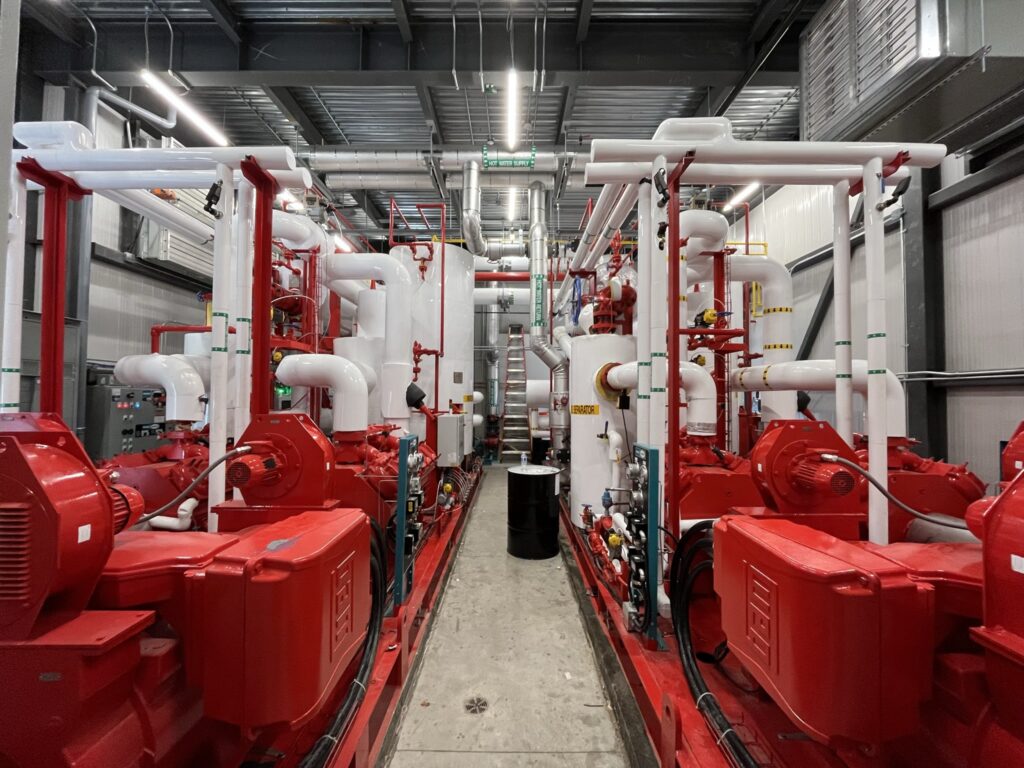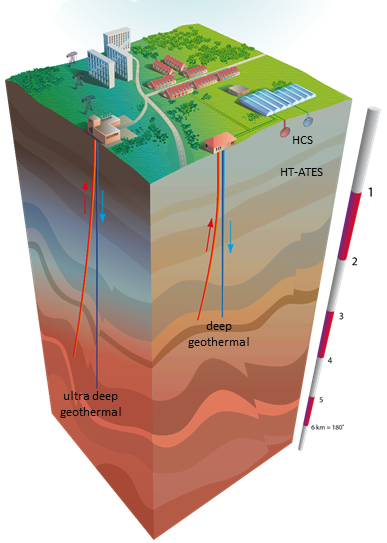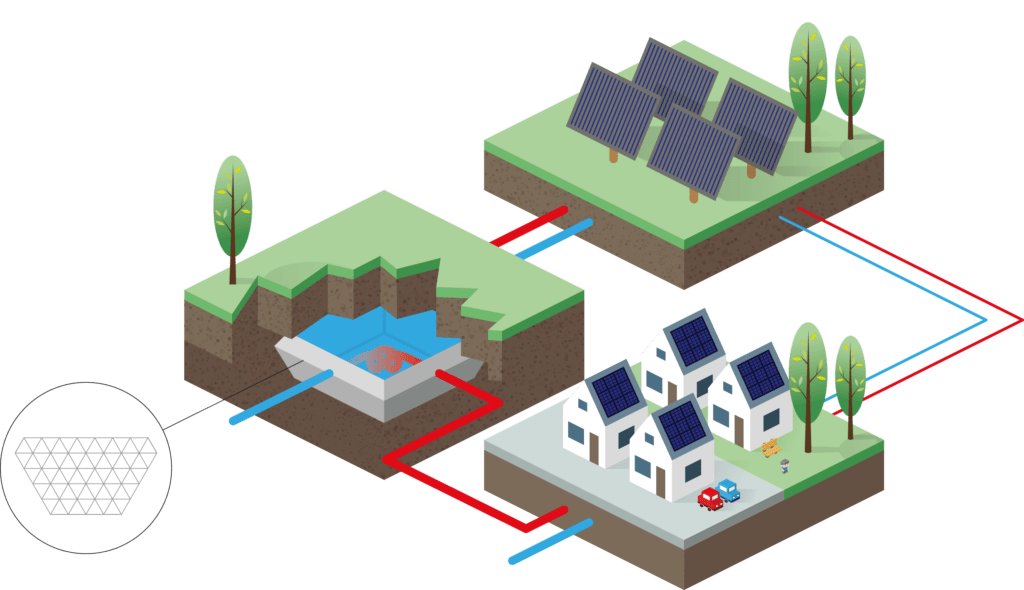
Low Carbon Technologies
Technologies that Benefit from District Energy
Biomass
Utilizing energy from biofuels works much better at larger scales due to the complexities and costs of transporting, storing, and vaporizing or combusting the fuel, and capturing the products of combustion. District Energy Systems are best suited to take advantage of bio-energy due to the larger and more consistent heating demand that helps with both economies of scale, increased run hours due to a flatter and more predictable load/energy profile, and dedicated professional operations staff.
FVB Energy’s bio-energy experience includes direct combustion of woody biomass in heat-only boilers, Organic Rankine Cycle Turbines, and steam turbine CHP systems. We have also worked with biogas, including design of fueling stations for buses in Linkoping, Sweden. The biogas is produced from household waste, animal waste, and agricultural waste. FVB Energy’s bio-energy experience includes both direct combustion of woody biomass in heat-only boilers as well as both Organic Rankine Cycle Turbines and/or steam turbine CHP systems. We have also worked with biogas, including design of fueling stations for buses in Linkoping, Sweden. The biogas is produced from household waste, animal waste and agricultural waste.
Image: City of Revelstoke, British Columbia


Wastewater Energy Transfer (WET)
Sewage or wastewater systems contain an incredible amount of latent energy that is literally flushed down the drain. This consistent source of 15-25°C liquid makes an ideal heat source or heat sink for a heat pump. The challenge with implementing wastewater energy transfer systems is the complexities of exchanging the energy with the wastewater, while not disrupting the operation of the wastewater system. This energy exchange can happen on the treated side (i.e. effluent) at a wastewater treatment facility, or on the raw untreated side, by directly exchanging from a sewer trunk. While there are many technologies that exist to accomplish this energy exchange in both scenarios, the challenge remains with the high costs and complexities of utilizing wastewater. In order to make a WET system economical and operational, a large heating or cooling demand is needed, along with a high utilization factor, allowing the technology to run for all hours of the year. District Energy Systems provide the perfect application for this technology, with the added benefit of year-round operators that can be trained to maintain and operate the systems.
In order to make a WET system economical and operational, you need to have a large heating/cooling demand and you need to have a high utilization factor meaning it can run for all hours of the year. District Energy systems provide the perfect application for these systems, and you get the added benefit or year-round operators that can be trained to maintain and operate the systems.
FVB Energy designed North America’s first district energy scale sewer heat recovery system that extracted heat from raw effluent at South East False Creek in Vancouver, BC. FVB is currently working on two new installations: for Corix and Lulu Island Energy Company with an expandible system (4 MW initial, 8 MW future); and with Markham District Energy to design the worlds largest Wastewater Energy Transfer System (18.75 MW), both utilizing untreated wastewater from an adjacent trunk sewer.
GeoExchange/Geothermal Exchange
Geo-exchange systems, sometimes mistaken as geothermal, involve the transfer of energy to and from the nearby ground. This transfer of energy can be beneficial as the ground temperature stays relatively stable compared to the outdoor air. For example, on a cold winter day in Canada when it can reach -20°C (-4°F) outside, the ground can be anywhere between 5-10°C (41-50°F) at a relatively shallow depth of 240m (~ 800ft deep). This energy transfer takes place by burying a series of closed loop pipes that circulate water or glycol to exchange heat with the ground. This tempered fluid is then utilized by heat pumps to either produce heated or chilled water for space conditioning and/or potable hot water. These systems can be more energy efficient then air-source heat pumps which try to extract energy from the surrounding air which is much less efficient when air temperatures are low. Special considerations must always be made to ensure the heat you are pulling out of the ground in the winter, is the same as the heat you are rejecting to the ground in the summer. Any unbalance could result in the ground temperature changing over time and reducing the efficiency of the geo-exchange system.
District Energy Systems make great hosts for geo-exchange technology as the mature heating and cooling loads can provide the necessary heating and cooling demands to keep the geo-exchange systems balanced between winter and summer operation. FVB Energy has successfully integrated geo-exchange systems into many district energy systems.


Combined Heat & Power (CHP)
Using combined heat and power (abbreviated as CHP) results in heat and electrical power simultaneously being generated off of a single fuel. This can be anything from a fossil fuel (natural gas, fuel oil, etc.) to biofuels (biogas, biomass, landfill gas, etc.) to nuclear heat recovery (SMRs, MMRs, etc.). Traditional methods for CHP include reciprocating engines, steam turbines, and ORCs turbines. Newer emerging technologies such as small modular reactors (SMRs) and micro modular reactors (MMRs) are examples of how CHP can be utilized to benefit communities with a thermal energy network. The prime benefit of CHP systems is the higher realized efficiencies than those same energy streams were being produced independently. Which technology is best suited to a project will depend on many factors including the size, the available fuel source, and the required temperature on the thermal loop. The electricity generated from CHP can either be used by the operator in a behind-the-meter application or can be exported/sold to the local electricity supplier/distributor through a feed-in-tariff program.
Many District Energy Systems in Canada and the US incorporate CHP systems, as they have large simultaneous thermal and electrical demands. Like all other alternative energy technologies, these systems benefit from increased run hours which DESs facilitate.
Image: A facility powered by a combined heat and power CHP system utilizing waste heat to generate electricity.
Centralized Heat Pumps
Heat pumps are utilized all around us and we may not even know it: refrigerators stay cool by removing heat by way of a heat pump; and cars utilize heat pumps to heat and cool the cabin. Heat pump technology is nothing new but what is emerging is the development of high temperature water-to-water heat pumps. Traditionally, heat pumps could produce both heating and cooling, but the heat was too low-grade to heat our homes. Today’s heat pumps, which utilize modern synthetic refrigerants with low Global Warming Potential, can produce upwards of 85-95°C hot water while maintaining efficiency. These heat pumps are often paired with supplemental systems such as geo-exchange, sewer heat recovery, or seasonal storage systems.
District Energy Systems, particularly those looking to electrify their heating systems, can greatly benefit from utilizing large scale heat pumps as a more economical way to produce heating and cooling energy than other electrical heating equipment. Heat pumps are often best utilized to produce baseload heating and cooling energy, which is easier to scale up at a district level. District Energy systems, particularly those looking to electrify their heating systems, can greatly benefit from utilizing large scale heat pumps as a more economical way to produce heating and cooling energy. Heat pumps are often best utilized to produce baseload heating and cooling energy which is easier to scale up at a district level.
Image: Marham District Energy Large Scale Heat Pumps


Deep Geothermal
Deep geothermal systems extract energy from the earths molten core. This typically requires much deeper drilling then geo-exchange systems and will depend on the local geological conditions. For example, all of Iceland is powered by geothermal energy, as they have an abundant source of thermal energy at a relatively shallow depth. One of the inherent benefits of deep geothermal is the energy source is constantly replenishing itself, and thus does not require a seasonal balance of energy extraction such as a geo-exchange system.
District Energy Systems provide a good opportunity to implement a deep geothermal system. The costs of drilling to these great depths can be prohibitive for smaller systems or stand-alone buildings and often require a large thermal load to justify.
Seasonal Thermal Storage
Thermal storage systems can take all shapes and forms. The basic idea of thermal storage is to bridge the gap between thermal energy production and usage. This is beneficial when access to a waste energy stream is not coincident with the need to utilize that energy.
Seasonal storage is quite common in climates that experience four seasons where there is excess cooling energy in the winter and excess heating energy in the summer. By storing this energy seasonally, these energy sources and demands can be synchronized to greatly improve system efficiencies. As building thermal storage with adequate insulation can be quite costly and space prohibited, it can sometimes be beneficial to look for natural storage opportunities such as aquifers, abandoned mines, etc., as this can help reduce costs and takes advantage of the earths natural insulating properties.

